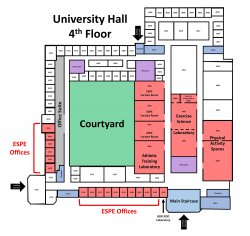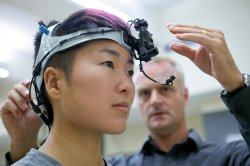The Department of Exercise Science and Physical Education in the College for Community Health is located in University Hall. This modern, $54-million seven-story building opened in 2005. The Exercise Science and Physical Education department is housed on the fourth floor. The laboratories in the department include the conjoined two-room Exercise Science Lab (located in University Hall rooms 4005-4007) with an attached Hydrostatic Weighing Lab (University Hall room 4007a), the Exercise Biochemistry Lab (University Hall room 4009), the BOD POD Lab (University Hall room 4101), the Athletic Training Lab (University Hall room 4054), the Motion Visual Behavior Lab (University Hall room 4004), and the Physical Activity Space (University Hall room 4002).
Exercise Science Laboratory
The Exercise Science Laboratory was established in 1958. The mission of the Exercise Science Laboratory is to facilitate basic and applied science research in the areas of physiology, biomechanics, and motor learning. The main Exercise Science space is 2,400 square feet of open floor space. The Exercise Science Lab is tall enough (≥12 ft tall) to allow for jumping tasks, and when the storable dividing wall is retracted the space is large enough to accommodate running and throwing tasks. A private Hydrostatic Weighing Lab is separated by permanent walls and a door, and there is another private space which acts as a BOD POD Lab just down the hall. There is direct access to the Exercise Biochemistry Laboratory. Large whiteboards and lecture projection systems are used during laboratory experiments and group instruction.
The Exercise Science Laboratory is well equipped and able to conduct a variety of teaching laboratory experiments and scientific research studies. The laboratory has the capacity to perform all common exercise tests using exercise bikes, treadmills, and resistance exercise equipment. Measurement capabilities include metabolic, body composition, stress testing, pulmonary testing, cardiovascular testing, ultrasound imaging, movement tracking, electromyography, ground reaction force assessment, eye tracking, and blood and urine analysis. The laboratory is also well equipped with computer hardware and software.

